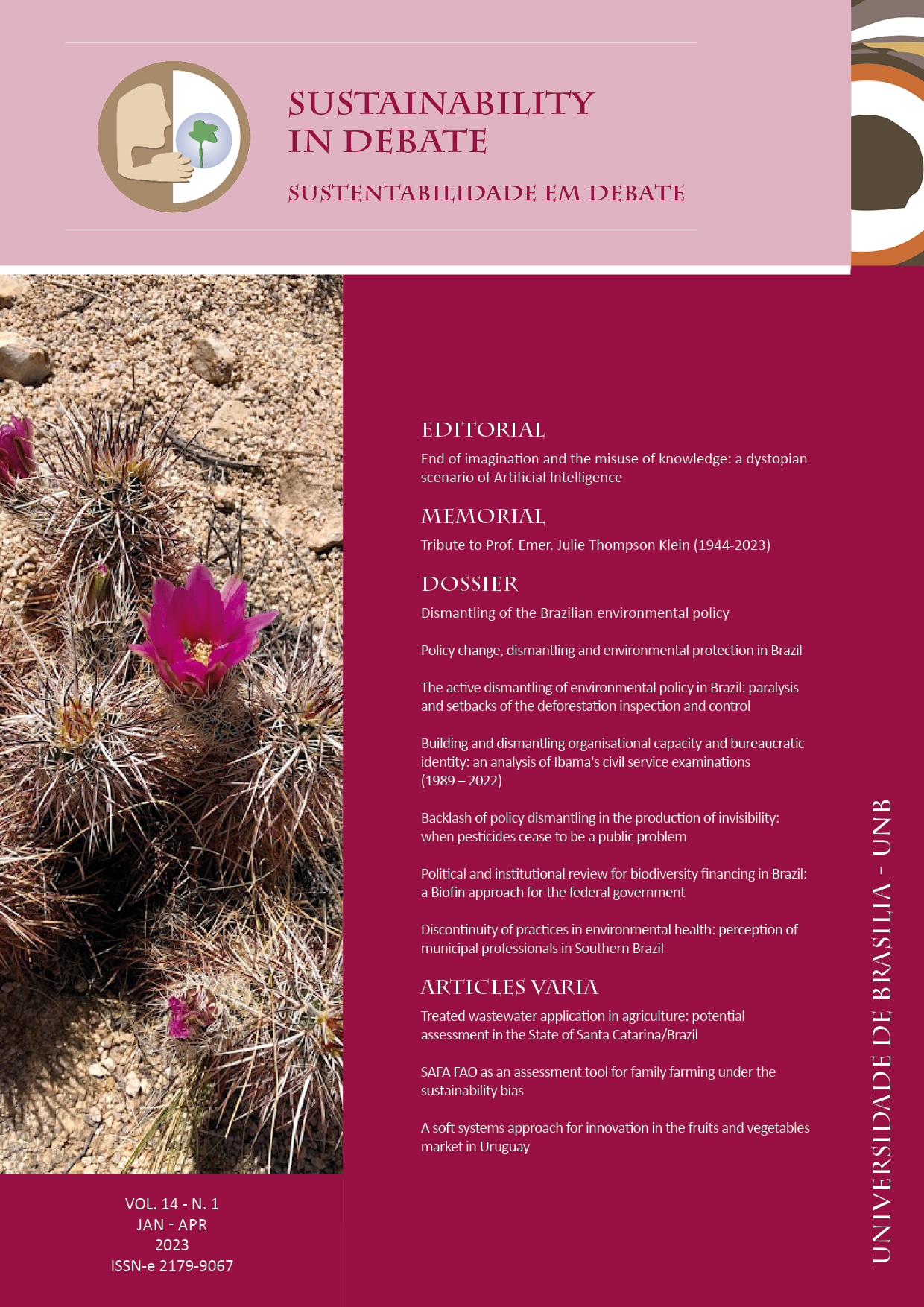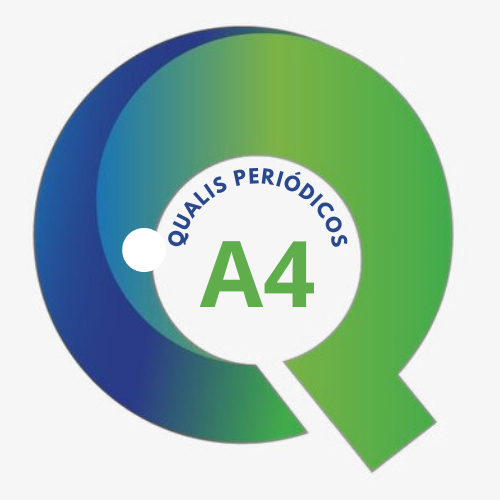Treated wastewater application in agriculture: potential assessment in the State of Santa Catarina/Brazil
DOI:
https://doi.org/10.18472/SustDeb.v14n1.2023.46670Palabras clave:
Ecological Sanitation, Irrigation, Reuse, Crops, Circular EconomyResumen
This study aimed to evaluate the potential of using treated wastewater in the irrigation of 7 crops produced in the State of Santa Catarina by assessing the current demand for irrigation water in the study area and the future production of treated wastewater. Food production data were collected from the most significant public agricultural institution in the study area to calculate their blue water footprint, given the amount of food harvested. Future wastewater production data were gathered from official reports which present the sanitation plans to be performed by 2035. Geographic Information System tools and risk assessment approaches were used to present and discuss results from quantitative and qualitative perspectives. Results show that the amount of wastewater to be produced in 2035 could not only supply the current irrigation water demand for the selected crops but also allow agriculture to expand without consuming more potable water.
Descargas
Citas
AGRICULTURAL RESEARCH AND RURAL EXTENSION COMPANY OF SANTA CATARINA – EPAGRI (EMPRESA DE PESQUISA AGROPECUÁRIA E EXTENSÃO RURAL DE SANTA CATARINA). Infoagro: vegetable production (Infoagro: produção vegetal). 2022. Available at: https://www.infoagro.sc.gov.br/index.php/safra/producao-vegetal. Accessed on: August 2022.
BARBAGALLO, S. et al.. Analysis of treated wastewater reuse potential for irrigation in Sicily. Water Science & Technology, p. 2024–2033, 2012. DOI: https://doi.org/10.2166/wst.2012.102.
BRASIL. Decree Nº 14.026, July 2020, Brasília. Sanitation Framework (Marco do Saneamento). Available at: http://www.planalto.gov.br/ccivil_03/_ato2019-2022/2020/lei/l14026.htm. Accessed on: August 2022.
BRASIL. Ministry of Regional Development (Ministério do Desenvolvimento Regional) National Sanitation Secretariat (Secretaria Nacional de Saneamento – SNS). National Sanitation Information System: 24th diagnosis of water and sewerage services – 2018 (Sistema Nacional de Informações sobre Saneamento: 24º diagnóstico dos serviços de água e esgotos – 2018). Brasília: SNS/MDR, 2019. 180 p.
BRAZILIAN INSTITUTE OF GEOGRAPHY AND STATISTICS – IBGE (INSTITUTO BRASILEIRO DE GEOGRAFIA E ESTATÍSTICA). 2017 Brazilian Census of Agriculture (Censo Agropecuário Brasileiro de 2017). Rio de Janeiro: IBGE. Available at: https://www.ibge.gov.br/en/statistics/economic/agriculture-forestry-and-fishing/21929-2017-2017-censo-agropecuario-en.html?=&t=destaques. Accessed on: August 2022.
COURAULT, D. et al.. Assessment and risk modeling of airborne enteric viruses emitted from wastewater reused for irrigation. Science of the Total Environment, 592, p. 512-526, 2017.
HECKENMÜLLER, M.; NARITA, D.; KLEPPER, G. Global availability of phosphorus and its implications for global food supply: an economic overview, Kiel Working Paper, No. 1897, Kiel Institute for the World Economy, Kiel, 2014.
JONSSON, H. et al.. Source separated urine-nutrient and heavy metal content, water saving and faecal contamination. Water science and technology, v. 35, n. 9, p. 145-152, 1997.
MAGRI, M. E.; PHILIPPI, L. S.; VINNERAS, B. Inactivation of pathogens in faeces by desiccation and urea treatment for application in urine-diverting dry toilets. Applied and Environmental Microbiology, v. 79, p. 2156-2163, 2013. DOI: https://doi.org/10.1128/AEM.03920-12.
MATHERS, C. D. et al. Global Burden of Disease 2000: version 2 methods and results. World Health Organization, Geneva, 2002.
MEKONNEN, M. M.; HOEKSTRA, A. Y. The green, blue and grey water footprint of crops and derived crops products, 2010.
MEKONNEN, M. M.; HOEKSTRA, A. Y. The green, blue and grey water footprint of crops and derived crop products. Hydrology and Earth System Sciences, v. 15, n. 5, p. 1577–1600, 2011. DOI: https://doi.org/10.5194/hess-15-1577-2011.
MOAZENI, M. et al. Estimation of health risks caused by exposure to enteroviruses from agricultural application of wastewater effluents. Water research, 125, p. 104-113, 2017. DOI: https://doi.org/10.1016/j.watres.2017.08.028.
NATIONAL WATER AGENCY – ANA (AGÊNCIA NACIONAL DE ÁGUAS). Wastewater Atlas (Atlas Esgoto). 2013. Available at: http://atlasesgotos.ana.gov.br/. Accessed on: August 2022.
OWAMAHO, H. I. et al. Fertiliser and sanitary quality of digestate biofertiliser from the co-digestion of food waste and human excreta. Waste management, v. 34, n. 4, p. 747-752, 2014.
ROST, S. et al. Agricultural green and blue water consumption and its influence on the global water system. Water Resources Research, 44, 2008. DOI: https://doi.org/10.1029/2007WR006331.
SECKLER, D. et al. World water demand and supply, 1990–2025: scenarios and issues. IWMI Research Report 19, IWMI, Colombo, Sri Lanka, 1998.
WIELEMAKER, R. C.; WEIJMA, J.; ZEEMAN, G. Harvest to harvest: recovering nutrients with New Sanitation systems for reuse in Urban Agriculture. Resources, Conservation and Recycling, p. 426-437, 2018.
WORLD HEALTH ORGANIZATION – WHO; UNITED NATIONS CHILDREN'S FUND – UNICEF. Progress on Drinking Water, Sanitation and Hygiene Update and SDG Baselines. World Health Organization. License: CC BY-NC-SA 3.0 IGO Geneva. 2017. Available at: https://apps.who.int/iris/handle/10665/258617. Accessed on: August 2022.
WORLD HEALTH ORGANIZATION – WHO. World health statistics 2018: monitoring health for the SDGs, sustainable development goals. World Health Organization. Geneva. 2018. Available at: http://apps.who.int/iris/bitstream/handle/10665/272596/9789241565585-eng.pdf. Accessed on: August 2022.
Descargas
Publicado
Cómo citar
Número
Sección
Licencia
Derechos de autor 2023 Sustainability in Debate

Esta obra está bajo una licencia internacional Creative Commons Atribución-NoComercial-SinDerivadas 4.0.
La presentación de la(s) obra(s) científica(s) original(es) por parte de los autores, como titulares de los derechos de autor de los textos enviados a la revista, de conformidad con la Ley 9.610/98, implica la cesión de derechos de autor de publicaciones impresas y/o digitales a la Revista de Sustenibilidad en Debate de los artículos aprobados para fines de publicación, en un único número de la Revista, autorizando también que la(s) obra(s) científica(s) aprobada(s) se divulguen de forma gratuita, sin ningún tipo de reembolso de derechos de autor, a través del sitio web de a Revista, para leer, imprimir y/o descargar el archivo de texto, a partir de la fecha de aceptación para publicación. Por lo tanto, los autores, al presentar los artículos a la Revista y, en consecuencia, la libre cesión de derechos de autor relacionados con el trabajo científico presentado, son plenamente conscientes de que no serán remunerados por la publicación de los artículos en la revista.Â
La Revista está licenciada bajo una licencia no comercial y sin derivaciones Creative Commons (No permite la realización de obras derivadas) 3.0 Brasil, con el propósito de difundir conocimientos científicos, como se indica en el sitio web de la publicación, que permite el intercambio del texto y el reconocimiento de su autoría y publicación original en esta revista.
Los autores pueden asumir contratos adicionales por separado, para la distribución no exclusiva de las obras publicadas en la revista Sustenibilidad en Debate (por ejemplo, en un capítulo de libro), siempre que se indique que los textos se publicaron originalmente en esta revista y que se menciona el DOI correspondiente. Se permite y incentiva a los autores a publicar y distribuir su texto online después de su publicación (por ejemplo, en repositorios institucionales o en sus páginas personales).Â
Los autores aceptan expresamente los términos de esta Declaración de Derechos de Autor, que se aplicará a la presentación si es publicada por esta Revista.






